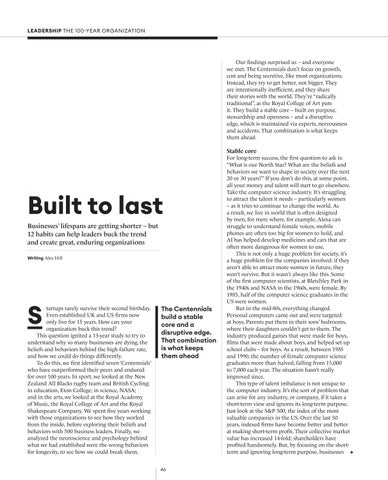LEADERSHIP THE 100-YEAR ORGANIZATION
Our findings surprised us – and everyone we met. The Centennials don’t focus on growth, cost and being secretive, like most organizations. Instead, they try to get better, not bigger. They are intentionally inefficient, and they share their stories with the world. They’re “radically traditional”, as the Royal College of Art puts it. They build a stable core – built on purpose, stewardship and openness – and a disruptive edge, which is maintained via experts, nervousness and accidents. That combination is what keeps them ahead.
Stable core
Built to last Businesses’ lifespans are getting shorter – but 12 habits can help leaders buck the trend and create great, enduring organizations Writing Alex Hill
S
tartups rarely survive their second birthday. Even established UK and US firms now only live for 15 years. How can your organization buck this trend? This question ignited a 13-year study to try to understand why so many businesses are dying, the beliefs and behaviors behind the high failure rate, and how we could do things differently. To do this, we first identified seven ‘Centennials’ who have outperformed their peers and endured for over 100 years. In sport, we looked at the New Zealand All Blacks rugby team and British Cycling; in education, Eton College; in science, NASA; and in the arts, we looked at the Royal Academy of Music, the Royal College of Art and the Royal Shakespeare Company. We spent five years working with those organizations to see how they worked from the inside, before exploring their beliefs and behaviors with 500 business leaders. Finally, we analyzed the neuroscience and psychology behind what we had established were the wrong behaviors for longevity, to see how we could break them.
The Centennials build a stable core and a disruptive edge. That combination is what keeps them ahead
For long-term success, the first question to ask is: “What is our North Star? What are the beliefs and behaviors we want to shape in society over the next 20 or 30 years?” If you don’t do this, at some point, all your money and talent will start to go elsewhere. Take the computer science industry. It’s struggling to attract the talent it needs – particularly women – as it tries to continue to change the world. As a result, we live in world that is often designed by men, for men; where, for example, Alexa can struggle to understand female voices, mobile phones are often too big for women to hold, and AI has helped develop medicines and cars that are often more dangerous for women to use. This is not only a huge problem for society, it’s a huge problem for the companies involved: if they aren’t able to attract more women in future, they won’t survive. But it wasn’t always like this. Some of the first computer scientists, at Bletchley Park in the 1940s and NASA in the 1960s, were female. By 1985, half of the computer science graduates in the US were women. But in the mid-80s, everything changed. Personal computers came out and were targeted at boys. Parents put them in their sons’ bedrooms, where their daughters couldn’t get to them. The industry produced games that were made for boys, films that were made about boys, and helped set up school clubs – for boys. As a result, between 1985 and 1990, the number of female computer science graduates more than halved, falling from 15,000 to 7,000 each year. The situation hasn’t really improved since. This type of talent imbalance is not unique to the computer industry. It’s the sort of problem that can arise for any industry, or company, if it takes a short-term view and ignores its long-term purpose. Just look at the S&P 500, the index of the most valuable companies in the US. Over the last 50 years, indexed firms have become better and better at making short-term profit. Their collective market value has increased 14-fold; shareholders have profited handsomely. But, by focusing on the shortterm and ignoring long-term purpose, businesses
46
046-049_Dialogue_Q1_2024.indd 46
27/10/2023 14:42
